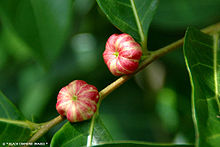- Glochidion ferdinandi
-
Glochidion ferdinandi 
mature fruit Scientific classification Kingdom: Plantae (unranked): Angiosperms (unranked): Eudicots (unranked): Rosids Order: Malpighiales Family: Phyllanthaceae Genus: Glochidion Species: G. ferdinandi Binomial name Glochidion ferdinandi
(Muell.Arg.) F.M.BaileyGlochidion ferdinandi, commonly known as the cheese tree, is a species of tree in the Phyllanthaceae family. It is native to eastern Australia, where it grows in rainforests and wetter sclerophyll forests. Frugivorous birds such as pigeons, figbirds and parrots consume its fruit.
Contents
Description
It grows as a woody shrub or small tree to 8 metres (26 ft), although occasionally reaching 30 metres (98 ft), with flaky brownish-grey bark. It has simple alternate-arranged elliptical leaves 3–10 centimetres (1.2–3.9 in) in length and −-5.5 centimetres (−0.98 in) wide; the species may be partly deciduous in winter. Flowering may occur at any time of year; the cheese tree has both single female and male flowers, which are found in groups of three. Both sexes are green-yellow, with the male flowers about 0.7 cm and the female 0.5 cm in diameter. The most notable feature are the small pumpkin-shaped fruit, which are green at first before turning shades of white and pink. Divided into segments radially, they eventually split open to reveal bright red 0.5 cm seeds from November to April.[1][2]
Taxonomy and naming
The cheese tree gains its common name for its cheese-shaped fruit.[2] Other common names include water gum, button wood, pencil cedar, and jow-war. The cheese tree was originally described by Swiss botanist Johannes Müller Argoviensis in 1865 as Phyllanthus ferdinandi before being given its current binomial name by Frederick Manson Bailey in 1902. Its specific epithet honours Victorian State Botanist Ferdinand von Mueller.[1]
An uncommon variety, pubens, known as the hairy cheese tree, is smaller, with leaves and fruit finely hairy.
Distribution and habitat
The cheese tree grows in both clay and sandy soils, and is found in rainforest and wetter areas in sclerophyll forest, where it may be associated with such species as Bangalay (Eucalyptus botryoides), Woollybutt (E. longifolia), Forest Red Gum (E. tereticornis) Thin-leaved Stringybark (E. eugenioides) and swamp she-oak (Casuarina glauca).[3] The hairy cheese tree grows with magenta lilly pilly (Syzygium paniculatum), broad-leaved paperbark (Melaleuca quinquenervia), and Rhodomyrtus species.[3]
It is found from central Queensland to the vicinity of Ulladulla (35° S) in southern New South Wales.[1]
Ecology
The fruits are eaten by several bird species, including the Australasian Figbird (Sphecotheres vieilloti), Lewin's Honeyeater, (Meliphaga lewinii), Olive-backed Oriole (Oriolus sagittatus), White-headed Pigeon (Columba leucomela),[4] Topknot Pigeon (Lopholaimus antarcticus), Brown Cuckoo-dove (Macropygia phasianella), Australian King Parrot (Alisterus scapularis)[5] The Pied Currawong (Strepera graculina) also eats the fruit but regurgitates them, while new leafy growth is eaten by the Rainbow Lorikeet (Trichoglossus haematodus).[3] It also serves as food for the larvae of the Shining Pencil-blue (Candalides hellenita),[6] and the Shining- or Common Oak-blue (Arhopala micale).[7]
The ladybird Scymnodes lividigaster feeds on the aphid Aphis eugeniae, which feeds on the cheese tree.[8]
Glochidion ferdinandi is a long-lived species which may live for 60 years or more. It may sucker or resprout after bushfire. Seeds take 1–4 months to germinate.[3]
Cultivation
It is an easily grown pioneer species useful in bush regeneration and natural landscaping of areas to which it is native in eastern Australia. The species may colonise disturbed areas, and is a fast growing plant. Plants require ample water but adapt to a wide range of soils and sun or shade.[1] It can be grown as an indoor plant in a bright position.[9]
References
- ^ a b c d Eliot R. W., Jones D. L., Blake T. (1986). Encyclopaedia of Australian Plants Suitable for Cultivation: Volume 4 (Eu-Go). Port Melbourne: Lothian Press. pp. 365–66. ISBN 0-85091-589-9.
- ^ a b Fairley A., Moore P. (2000). Native Plants of the Sydney District:An Identification Guide (2nd ed.). Kenthurst, NSW: Kangaroo Press. pp. 98–99. ISBN 0-7318-1031-7.
- ^ a b c d Benson, Doug and McDougall ,Lyn (1995). "Ecology of Sydney Plant Species:Part 3:Dicotyledon families Cabombaceae to Eupomatiaceae" (pdf). Cunninghamia 4 (2): 217–431. Archived from the original on 2008-07-24. http://web.archive.org/web/20080724095654/http://www.rbgsyd.nsw.gov.au/__data/assets/pdf_file/57847/Cun4Ben217.pdf. Retrieved 2008-08-22.
- ^ Floyd, A. G. (1989). Rainforest trees of mainland south-eastern Australia. Sydney: Inkata Press. ISBN 0-909605-57-2.
- ^ Barker, R. D. and Vestkens, W. J. M. (1989). Food of Australian Birds: Volume 1 Non-Passerines. CSIRO Publishing.
- ^ Braby, Michael F. (2005). The Complete Field Guide to Butterflies of Australia. Collingwood, Victoria: CSIRO Publishing. pp. 258. ISBN 0-643-09027-4.
- ^ Braby, p. 232
- ^ Anderson J. M. E. (1982). abstract "Seasonal Habitat Utilization and Food of the Ladybirds Scymnodes Lividigaster (Mulsant) and Leptothea Galbula (Mulsant) (Coleoptera: Coccinellidae).". Australian Journal of Zoology 30 (1): 59–70. doi:10.1071/ZO9820059. http://www.publish.csiro.au/paper/ZO9820059.htm abstract. Retrieved 2008-08-22.
- ^ Ratcliffe, David & Patricia (1987). Australian Native Plants for Indoors. Crows Nest, NSW: Little Hills Press. pp. 94. ISBN 0-949773-49-2.
External links
- "Glochidion ferdinandi". Australian Plant Name Index (APNI), IBIS database. Centre for Plant Biodiversity Research, Australian Government. http://www.anbg.gov.au/cgi-bin/apni?taxon_id=23833.
Categories:- Glochidion
- Flora of Queensland
- Flora of New South Wales
- Malpighiales of Australia
- Trees of Australia
Wikimedia Foundation. 2010.
